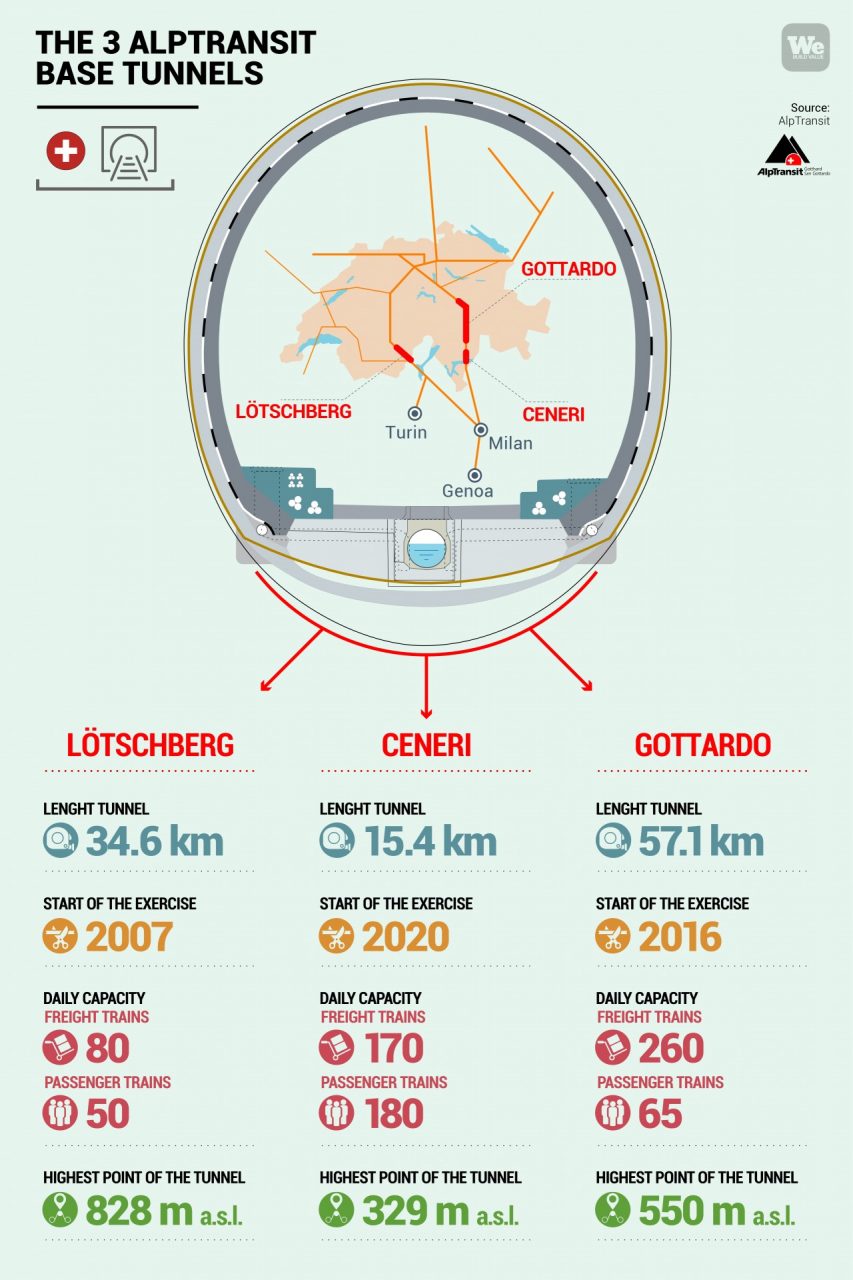The AlpTransit project, one of the largest and most expensive infrastructure works in Switzerland’s history, has an ambitious three-part goal: traveling beneath and around the Alps, mitigating environmental impact by reducing road traffic in favor of rail, and connecting northern and southern Europe with a modern railway.
The project has involved creating a capillary railway infrastructure, extending from northern Switzerland to Italy through three base tunnels, including the Gotthard Pass, which is now the longest railway tunnel in the world.
Three tunnels through the Alps
The most complex feat of engineering in the entire AlpTransit project was the construction of three tunnels that facilitate movement of high-capacity trains under the mountains. This significantly shortens travel times.
The first Lötschberg tunnel is 34.6 kilometers (21.5 miles) long, and became operational in 2007; the second and longest, the Gotthard tunnel, is 57.1 kilometers (35 miles) long and has been open since 2016; while the third, the Ceneri Base tunnel, is 15.4 kilometers long (9.6 miles) and became operational in 2020.
The traffic capacity of these major infrastructures is monumental. For reference, the Lötschberg Tunnel has a daily capacity of 80 freight and 50 passenger trains; the Gotthard Tunnel 260 freight and 65 passenger trains; and the Ceneri Base Tunnel 170 freight and 180 passenger trains.
The Webuild Group took part in construction of the Gotthard Base Tunnel, responsible for the two southernmost sections of the project, the Bodio and Faido lots. Together they cover 30 of the work’s total 57 kilometers (or 18.6 of the work’s total 35.4 miles).
The infrastructure is incredible, not just for its length, but for the complicated challenge posed by the mountains the railway crosses. In some areas, the amount of rock above the tunnel reaches heights of 2,300 meters (7,546 feet). Down below, trains travel at a speed of 250 km/h (155 miles/h) while keeping one of the most beautiful mountain ranges in the Swiss Alps intact.
Impact of AlpTransit on passengers and goods
The line’s capillarity, paired with its mountain-crossing capacity, has significantly reduced track length, helping to cut down on travel time between the locations the trains serve.
On the Gotthard axis, it takes just two hours to move between Zurich and Lugano and only three to reach Milan from Zurich. A new connection is currently being built on the Lugano-Locarno section, and will reduce travel time by 30 minutes on that portion alone.
The project will also have a significant impact on freight traffic. The completion of the Ceneri Base Tunnel (operational since 2020) effectively inaugurated a flat railway through the Alps. This allows the trainsets to travel with just one locomotive (previously two were needed, due to the gradient on some mountain passes). The single locomotive can be longer and heavier, however, allowing a larger quantity of goods to be transported.
This will benefit the entire freight traffic system that revolves around the Rotterdam-Genoa rail corridor, which was designed to serve an economically strong area that produces 16% of European GDP. Crossing Switzerland, the line reaches Milan from the future starting point of the Terzo Valico dei Giovi railway line. The high-speed link, which the Webuild Group is currently working on, connects Milan to Genoa. Like AlpTransit, the TerzoValico is unique because 37 (23 miles) of the line’s 54 kilometers (33.6 miles) will be in tunnels. This engineering choice was needed to facilitate movement through the mountains between Lombardy and Liguria, allowing high capacity trains to reach the port of Genoa.
AlpTransit: the lengthy process behind an infrastructure that changed Europe
From the beginning, creating a high-capacity railway to shift transport trends away from road movement has been about responding to real-life needs of the Swiss population. To date, investments in the AlpTransit project have totaled CHF23 billion Swiss francs (€20.7 billion). This amount was approved on multiple occasions through voters’ referendums, confirming mainstream interest in more sustainable transport models.
Project planning and implementation began some time ago. Analysis of variations for the rail line, which dated back to the 19th century and passed over the Alps, started in 1963. The Swiss Federal Council gave initial approval for the three-tunnel project in 1989, but it did not receive funding until 1998. Finally, in 2007, the first tunnel was inaugurated, and work continued until 2020, when the Ceneri base tunnel was completed. While the route between Switzerland and Milan is up and running, the AlpTransit project is not yet technically complete.
Currently, studies are underway to increase the Lötschberg tunnel’s transport capacity, as are studies exploring the possibility of expanding a section of the line toward Chiasso. The timetable for all of these operations will likely extend until 2035, a long-term scope common to major works like this.


